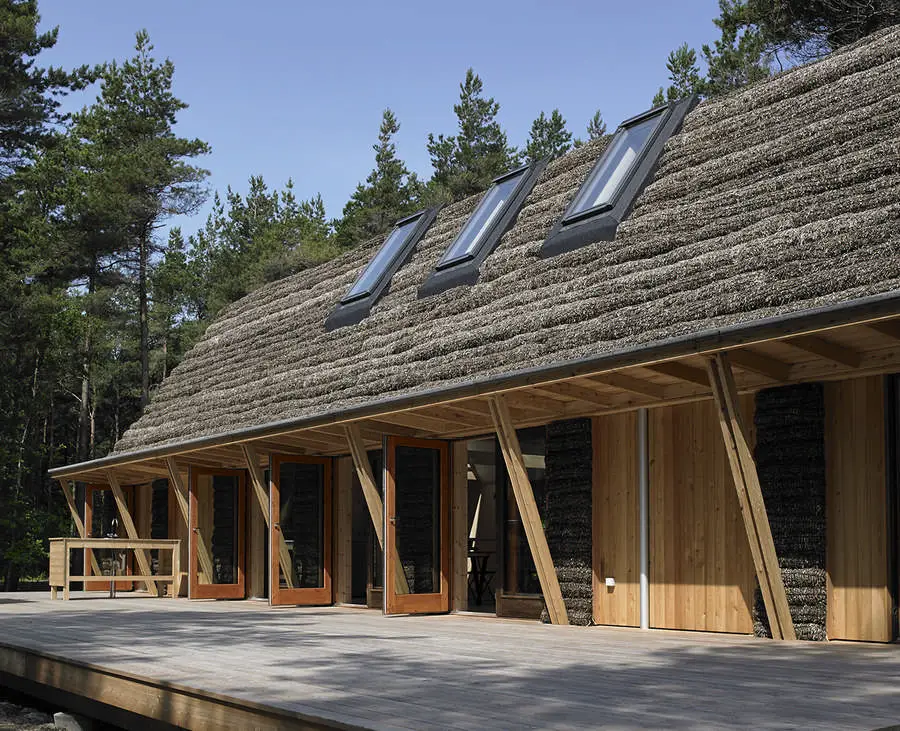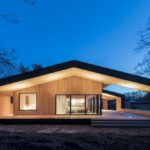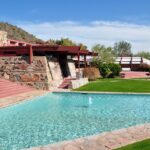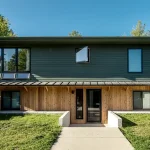Danish Seaweed House, New Rural Property in Denmark, Building, Photos, Design
Modern Seaweed House, Denmark
Residence on island of Læsø, Denmark – design by Vandkunsten
20 Nov 2013
Modern Seaweed House on Læsø
The cultural heritage of Læsø: A resource in sustainable building
Design: Vandkunsten ; Realdania Byg
On the small island of Læsø in Denmark, a several hundred-year-old building style has formed the basis on which a new holiday house has been built – the Modern Seaweed House. The house is designed by Vandkunsten firm of architects and developed by Realdania Byg as a holiday house built in wood, covered and insulated with seaweed. The Modern Seaweed House is carefully adapted into the landscape and has a wonderful interaction with nature, the historic buildings and Læsø’s unique cultural history. The Modern Seaweed House is now to be sold – but the ideas live on.

photo : Helene Høyer Mikkelsen, Realdania Byg
The Modern Seaweed House is part of the Realdania Byg project ‘Seaweed Houses on Læsø’ that also includes ‘Kaline’s House’ – a listed seaweed house from 1865, purchased and carefully restored by Realdania Byg in 2012. The seaweed houses on Læsø are an exceptional part of the cultural heritage of Denmark – and the world. Originally, several hundred of these seaweed houses were found all over Læsø while only approximately twenty remain today. The traditional seaweed houses were built using a timber frame construction with robust seaweed roofing – an abundant resource in the small and modest fishing community. ‘Kaline’s House’ is one of these houses.
‘The seaweed houses on Læsø are physical testimony to the culture and the life that have characterised the building tradition on the island for centuries. The starting point of the Modern Seaweed House has been to explore this unique archive of cultural and architectural history and employ the past as source for contemporary architecture. It is our hope that others will embrace the experiences from this project and develop the ideas even further,’ says Peter Cederfeld, managing director of Realdania Byg.




photos : Helene Høyer Mikkelsen, Realdania Byg
The Modern Seaweed House is not a replica of the building style of the past but a development inspired by the architectural history of Læsø. In contrast to the historic houses, on which the seaweed is stacked high on the roof, the Modern Seaweed House is more contemporary and tight in its expression. The visible seaweed has been stuffed into bolsters made of knitted nets attached to the façade in lengths. At the same time, seaweed is used invisibly for insulating floors, walls and ceilings enclosed in wooden cassettes. These prefabricated building modules comprise the framework of the house.
A sustainable resource
When seaweed was used in the past as a building material it was due to the fact that seaweed was found just outside the door, it was free, had a long-term durability, was very effective as insulation, naturally protected against vermin and putrefaction, and, finally, there was lots of it. These very preconditions make seaweed of current interest as a building material, especially in the light of the present attention to the topic of sustainability. The Modern Seaweed House fulfils expected 2020 demands, and, thereby, will have extremely low energy consumption.
At the same time, LCA (life cycle analysis) calculations have shown that the house actually has a negative carbon footprint. The almost exclusive use of organic materials, including seaweed used as both insulation and roofing material, causes the amount of CO2 accumulated within the house to exceed that which has been emitted during the production and transportation of the building materials.
‘By using seaweed in the construction, we not only secure the continued supply of seaweed for use on the historic houses, we also reintroduce a material to the modern building industry which is CO2-reducing, environmentally friendly and sustainable in a broader sense,’ says architect and project manager in Realdania Byg, Jørgen Søndermark.
In a broader view
With the ‘Seaweed Houses on Læsø’ project, Realdania Byg wishes to focus on the unique tradition of Læsø using seaweed as a building material – both the immediate need to ensure the architecture of the past and the at least equally relevant need to develop the architecture in a sustainable approach. This way, seaweed is also ensured for restoring the historic houses.
Realdania Byg’s project to develop and preserve seaweed houses on Læsø is one among a variety of existing projects that aim to secure the survival of the distinctive seaweed roofs on Læsø. The initiative is carried out in unison with enthusiastic inhabitants of Læsø, other foundations as well as the Danish Agency for Culture who are all involved in the effort to save this rather exceptional part of the cultural heritage of Denmark – and the world.
The Modern Seaweed House has shown that eelgrass has a lot of qualities. Besides its excellent insulating property and long-term durability, which in itself offer a lot of potential, it has been discovered through practical application that seaweed has exceptional acoustic properties. This creates surprisingly comfortable rooms while the ability to absorb and give off moisture contributes to regulate a good indoor climate. The numerous qualities provide a wide range of applications in modern, sustainable building.
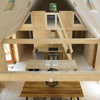
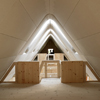
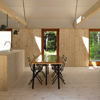
photos : Helene Høyer Mikkelsen, Realdania Byg
Facts – The Modern Seaweed House
The Modern Seaweed House is built from prefabricated wooden cassettes that comprise the floor, façades and roof. Seaweed is featured as insulation within the cassettes themselves, as padding inside the acoustic ceiling draped in flax as well as for cladding both the façade and the roof. In contrast to the historic houses, on which the seaweed is stacked high on the roof in a tall, swelling, mushroom-like fashion, the Modern Seaweed House is more contemporary and tight in its expression. The visible seaweed has been stuffed into bolsters made of net knitted in strong wool. The bolsters are attached to the roof in overlapping runs and, in smaller scale, mounted on the façades using the same method.
The house is designed by Vandkunsten firm of architects and erected 2012-2013. The prefabricated elements have been made at Green House in Kongerslev who have also been lead contractor on the construction and assembly of the house on Læsø. The padded ceiling elements have been made at Brian Liebeck in Frederiksberg on frames by Fab Lab in Næstved, while Praktisk Service in Stege along with trained thatcher Helle Raknes have been in charge of the production of the seaweed cladding. The seaweed comes from the two manufacturers on Bogø and Møn, respectively, who can provide the crucial seaweed of a decent quality after the seaweed plague destroyed most of the larger natural occurrences, including those south of Læsø, back in the 30s.
The house is 100 square metres and is built for two families: Centrally located is a large family room with a kitchen, which is bounded to each side by a core containing technical installations as well as bathroom and toilet. Behind these cores, in each end of the house, there is a very large room that can be divided into two reasonable rooms – and above this, a bed loft is located allowing for more sleeping places. The house is heated via a high-efficiency heat pump placed in an adjacent shed that can also be used for storing the families’ bikes, summer gear as well as a washing machine and a tumble dryer. The house is tight and effectively insulated and fitted with an efficient ventilation system with heat recovery. The effective insulation makes it possible in effect to live in the house year-round, or for instance maintain a constant temperature of minimum 10 degrees throughout the winter, making the house frost-free.
The Modern Seaweed House is situated on the northern part of Læsø at 6 Tangborgvej next to two other significant houses: Realdania Byg’s listed seaweed house, ‘Kaline’s House’, which was restored and refurbished prior to its inauguration in 2012, and today rented as a summer house, and Hanne Kjærholm’s summer house for the Rude family erected 1985-1987.
The house is now to be sold at market price.
Seaweed houses on Læsø
The seaweed houses on Læsø are an exceptional part of the cultural heritage, domestically and globally. Only very few seaweed houses still exist: approximately twenty in total, out of which eleven are listed. One of these houses is ‘Kaline’s House’, which Realdania Byg purchased and restored in 2012. At the time of acquisition, the house still had its original seaweed roof. The house was built more than 150 years ago and has 80 square metres of floor space. Kaline is a contraction of Karoline, which was the name of a previous inhabitant of the house. The house has now been carefully restored for posterity and remains as one of the few physical testimonies to the culture and the life, which have characterised the development on this beautiful island in northern Kattegat since the 1200s. ‘Kaline’s House’ was the first leg of the Realdania Byg project ‘Seaweed Houses on Læsø’, while The Modern Seaweed House makes up the second.
Since the first registration in the 70s, inhabitants of Læsø and friends of Læsø’s unique building style have fought to save the last remaining seaweed houses. With support from the Danish Nature Agency, a pilot project in the middle of the 90s revived the old techniques at an old seaweed farm, but it suffered from a lack of proper local seaweed. Within the past years, however, good and healthy eelgrass has surfaced in the Baltic Sea. This has coincided with people of Læsø resuming the struggle to attract outside attention to the cause, and, in 2008, support from several foundations has ensured that two local farmers on the coasts of Møn and Bogø have been able to take up the trade of their ancestors with systematic collection and drying of eelgrass. Previously, eelgrass from this area was – among other usages – used in mattresses, in Denmark branded as Getama – an acronym for Gedsted Tang Madrasser (Gedsted Seaweed Mattresses).
At the same time, support was given to another pilot project, this time with good seaweed laid on an entire roof of a smaller building. Thus, the work to retrieve skills and methods took a step further.
As the first half of the third pilot project, the Danish Culture Agency has bought and restored one of the listed seaweed houses, ‘Andrine’s House’ on 1 Alleen. The second half of pilot project number three is Realdania Byg’s old seaweed house, ‘Kaline’s House’, which was completed in the summer of 2012 following the full restoration and refurbishment. The Modern Seaweed House constitutes the fourth leg of the course.
Seaweed House on Læsø – Building Information
MATERIALS AND PRODUCTS:
Foundation: concrete pillars in a 240 cm grid.
Floor slab: Prefab timberframe (softwood) panels clad with cement fiber boards on bottom side, PE membrane on top. In bathrooms: cast concrete on Lewis steel plates.
Facade walls: Prefab timberframe (softwood) panels clad with OSB on both sides, tar felt on outside, PE on inside.
Roof: Prefab timberframe (softwood) panels clad with OSB on both sides, tar felt on outside, PE on inside.
Interior walls and staircases: Prefab timberframes (softwood)
Airtightning: Dafa-tape.
Exterior sealant: Illmod expansion
Floors: Softwood boards 180×25 mm wiped with lye and white soap. Bathroom tiles: Winkelmans 10×10 cm, grey.
Interior wall cladding: Softwood boards 180×25 mm wiped with white soap.
Bathroom walls: liquid membrane, glass felt, white paint / partially tiles: Rako 15×15 cm, white.
Facade cladding: Seaweed (eelgrass) stuffed in hose of knitted wool, mounted in frames of larch battens. Partial: Vertical larch boards 125×21 with tongue and groove, untreated.
Roof cladding: Seaweed (eelgrass) stuffed in hoses of knitted wool, mounted on larch battens and pressed by hand into ellipsoid shape.
Ceilings: Seaweed stuffed in panels of softwood and MDF upholstered with linnet fabric.
Windows: Scandia Windows, passivehaus standard, low-energy u=0,8, triple glazing, Kebony-wood (pine)
Skylight windows: Velux Integra GGL, aluminum/softwood
HVAC/heatrecovering: Ecovent S600
Heatpump: Danfoss DHP
Faucets: Børmalux
Washbasins/toilets: Ifö
Modern Seaweed House on Læsø images / information from Realdania Byg
Location: Læsø, Denmark
Architecture in Denmark
Aniother Summer House in Denmark on e-architect
Summer House in Denmark
Design: Powerhouse Company
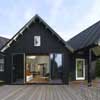
photo : Åke E. Son Lindman
Danish Summerhouse
Design: Powerhouse Company
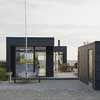
image from architects
Moesgård Museum Århus, Århus, Jutland
Henning Larsen Architects
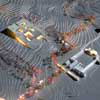
image from architect
House of Music Aalborg, Jutland
COOP HIMMELB(L)AU
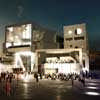
image © COOP HIMMELB(L)AU
Sorø Kunstmuseum, Sjælland, east Denmark
Design: Lundgaard & Tranberg Architects
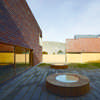
photo : Jens Lindhe
Comments / photos for the Modern Seaweed House on Læsøe page welcome

